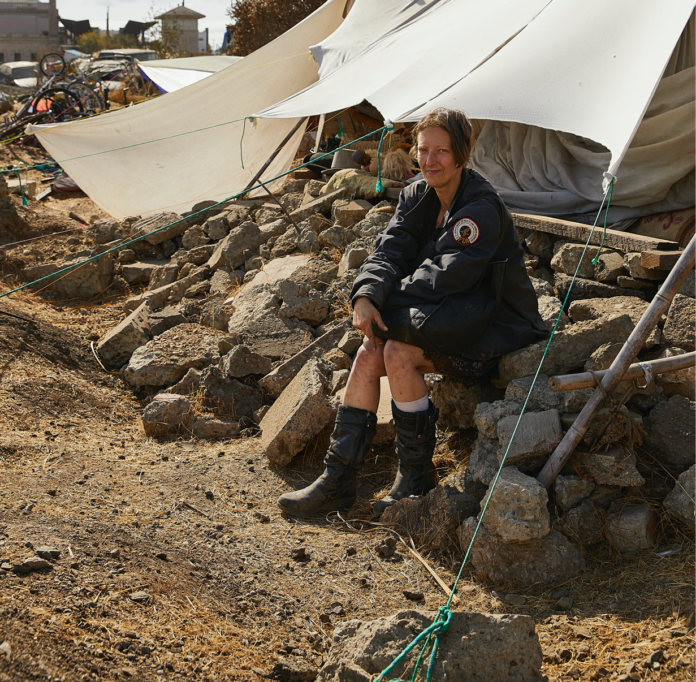
Oakland homeless residents organize to build community.
Oakland, like most cities on the West Coast, continues to face a growing housing crisis that has displaced record numbers of people from their homes. Unhoused residents are living outside, either on public land, in city-sanctioned supportive camping sites, or in other less-formal encampments. The City of Oakland has tested several solutions to provide shelter—from safe parking spaces for RVs, to supportive services at tent cities, to tiny wooden homes under the freeway and even modular housing—but the need continues to overwhelm the available options. Many city-operated sites limit people’s access to their outside community, constrain behaviors like drug and alcohol use, and restrict residents’ ability to come and go freely in an attempt to ensure the safety of all residents. Other city sites can only offer short-term housing, with the potential for future displacement.
Three communities in Oakland are pursuing a new model in which residents self-govern or co-govern in collaboration with nonprofits that help provide supportive services and facilitate relationships with city officials and landowners. In West Oakland, two long-standing neighboring encampments have partnered with housed neighbors, local businesses, and nonprofit advocates to prevent eviction and obtain social services while remaining independent of city jurisdiction. And on East 12th Street near Lake Merritt, a city-supported tiny-home village will host a group of displaced residents as they develop their own co-governance structures to facilitate shared decision-making.
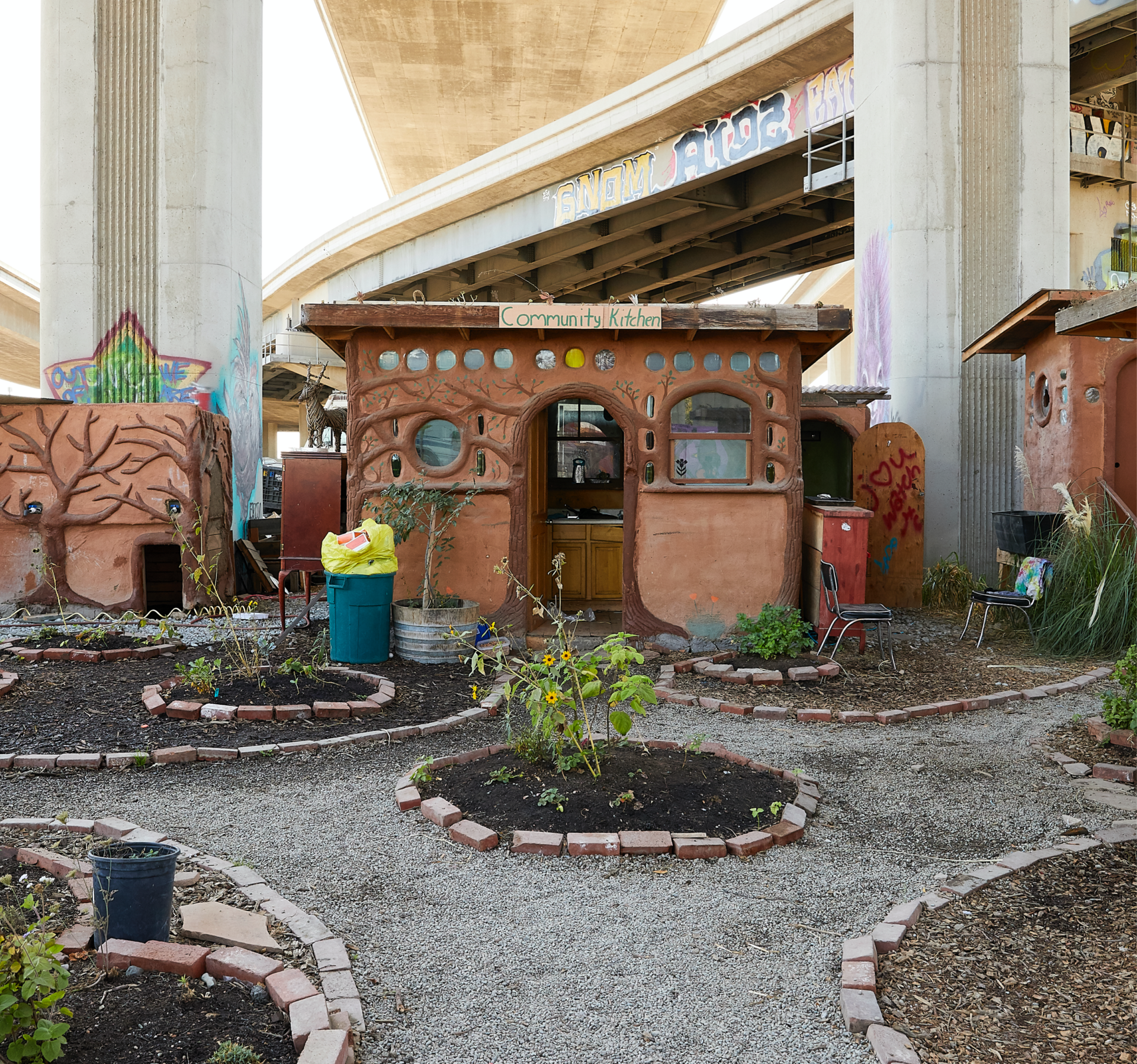
West Oakland Community Organizes for Autonomy
West Oakland is home to one of the largest encampments in California. Hundreds of residents and their individual and shared compounds span Wood Street from 18th to 34th Streets in the shadow of Highway 880. The Wood Street Commons, on the south side of the encampment, is on Oakland city property, while the northern portion, including the Cob on Wood community center, is on Caltrans land. The residents consider the area to be their home, although their community is not sanctioned or supported by city services. There have been persistent efforts by the City of Oakland and Caltrans to clear them from the space, in which makeshift homes, RVs, and cob structures are interspersed with vacant vehicles and scattered, illegally dumped garbage. Community members throughout the encampment have rallied together to create a loose government model in an effort to prevent their own eviction.
While the Cob on Wood encampment and its residents’ community have existed for several years, local nonprofits and neighboring housed residents began organizing early in the COVID-19 pandemic to provide shared resources and structures to better support community members. In March 2020, Essential Food and Medicine (EFAM) started doing mutual aid work in West Oakland to turn food surplus into health supplements and meals particularly for the Wood Street community, said director and co-founder Xochitl Bernadette Moreno. A collaboration was born between EFAM, Artists Building Community, and Living Earth Structures, who worked with housed and unhoused neighbors to fund and build community structures.
The residents first requested support to construct a full community kitchen, which was launched with the installation of a communal pizza oven on the northern end of the site. The three collaborating organizations each contributed $1,000 to purchase building materials and equipment for the kitchen and to install a toilet and a hot shower. The residents were offered stipends if they helped with the construction, mostly as an opportunity to teach the skills associated with cob building.
Most of the construction has been completed by volunteers and local businesses, Moreno said. Miguel Elliott, self-deemed “Sir Cobalot,” led the construction of the cob structures, which are more fire resistant than a typical wood structure because of the earthen exteriors. The buildings use wooden pallets as walls and discarded clothing as insulation. Although the cob structures are labor intensive, the materials are low-cost, since the earthen walls are built using subsoil and straw. Elliott’s business, Living Earth Structures, specializes in cob and adobe ovens, benches, and abodes. A GoFundMe campaign raised money to finish constructing the kitchen and also to construct a medical clinic that offers first aid supplies, overdose prevention tools, and clean needles; a vegetable garden area; and a community gathering space that includes a small stage. Found materials, such as pieces of old wine bottles, have been used to create windows, and cob sculptures make each building look like a work of art. Volunteers also built a “free store” that offers clothing, hygiene products, dog food, and other necessities at no charge, and a shower.
“We call it our Cobissary,” resident LeaJay Harper said. Harper has lived on Wood Street for nearly seven years, and she recalls the start of the recent community-building efforts somewhat differently. “It started because people started coming out here with this nasty-ass green juice. It was kind of spicy, it tasted healthy, you know,” she said, laughing. “I remember thinking, ‘What are all these white people doing here?’” Still, the collaboration between the nonprofits, neighborhood volunteers, local businesses, and residents got off the ground quickly, Harper said.
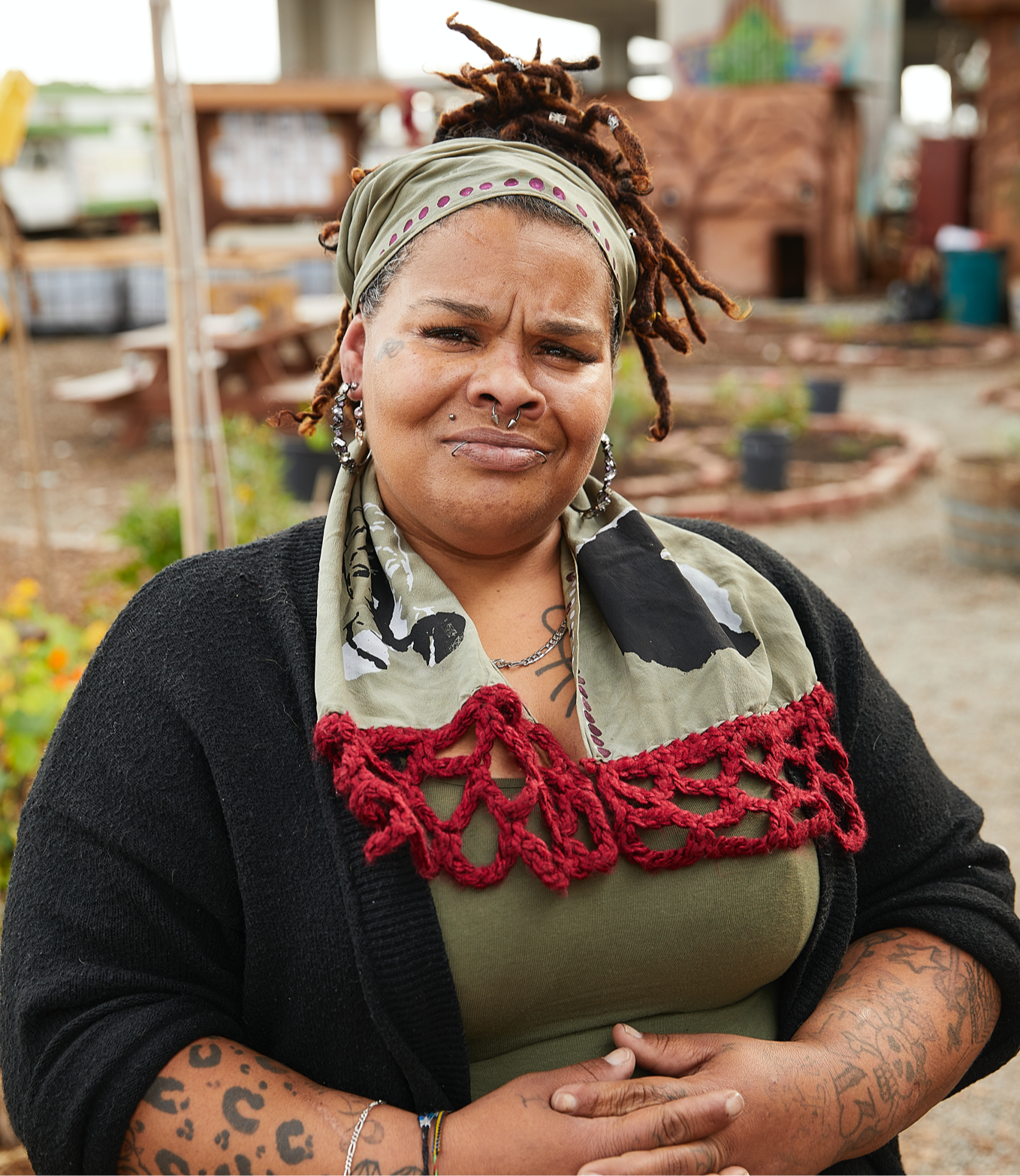
Once word got out about the communal kitchen, free food offerings, and especially the hot shower, people started joining the community, she said. “Helping with the building and engaging with other people really helps empower folks to engage in some of the things they used to do. It encourages us to go back to work or find temporary jobs to get new skills.” She said she worked in community organizing in San Francisco prior to losing her job, and the efforts to save her new home in Oakland and the community they’ve built there have reinvigorated her. “It’s our own family. Our own world. We’re united and it makes us stronger.”
Another resident, Ramona, has lived under the freeway near Wood Street since 2016, occasionally with her father. He died in late 2019, and hers was the first building constructed on the Caltrans land. Her metal home is set back from the new communal kitchen in a quiet corner of the encampment, and was built out of found materials, not cob, because it was constructed before Elliott joined the volunteer partnership.
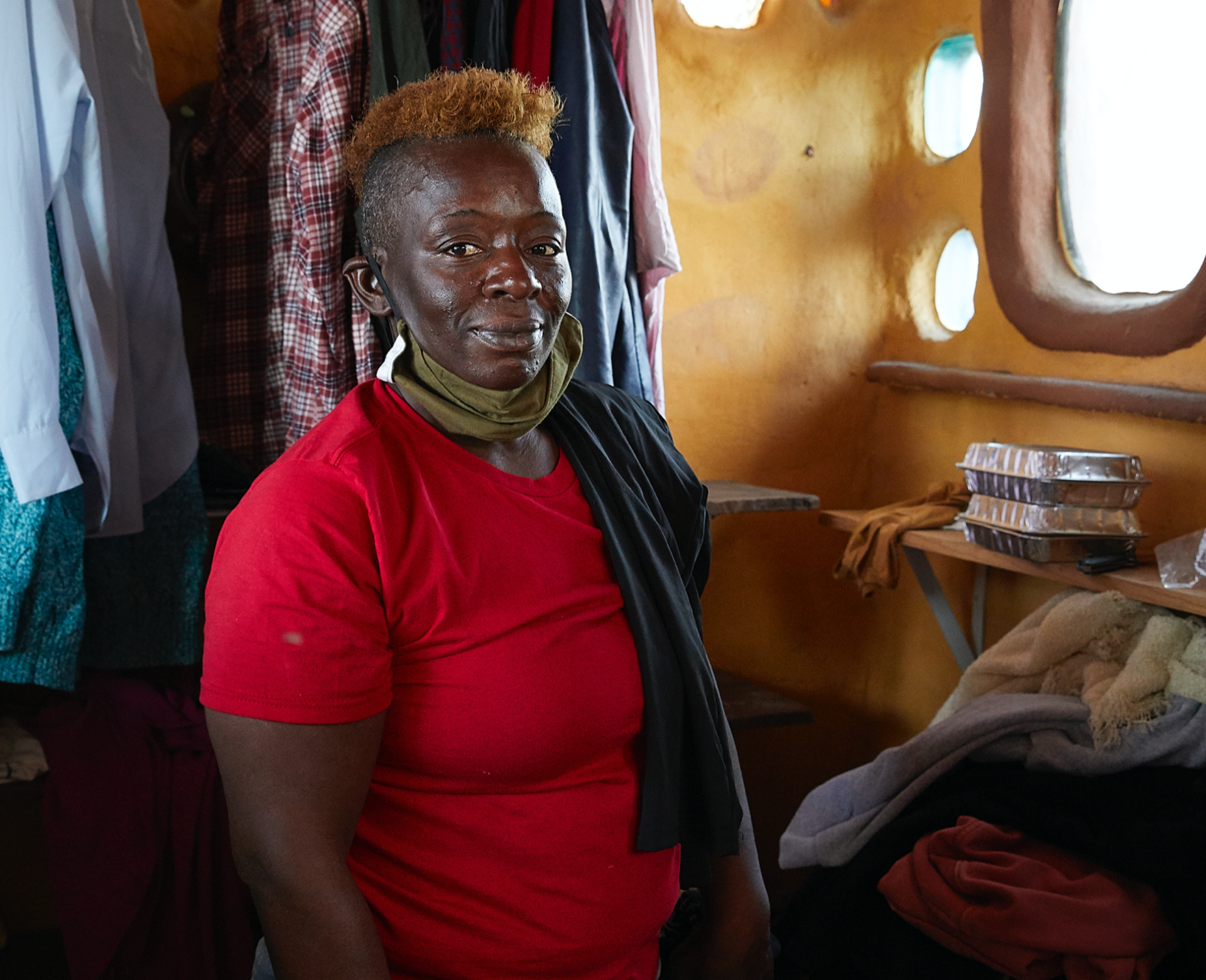
“It’s not a cob structure, but it’s mine, and it’s home,” Ramona said. Artists have decorated one whole side of her structure with a portrait of her father. She now volunteers with other residents by helping to stock the Cobissary and maintaining the gardens in the shared spaces.
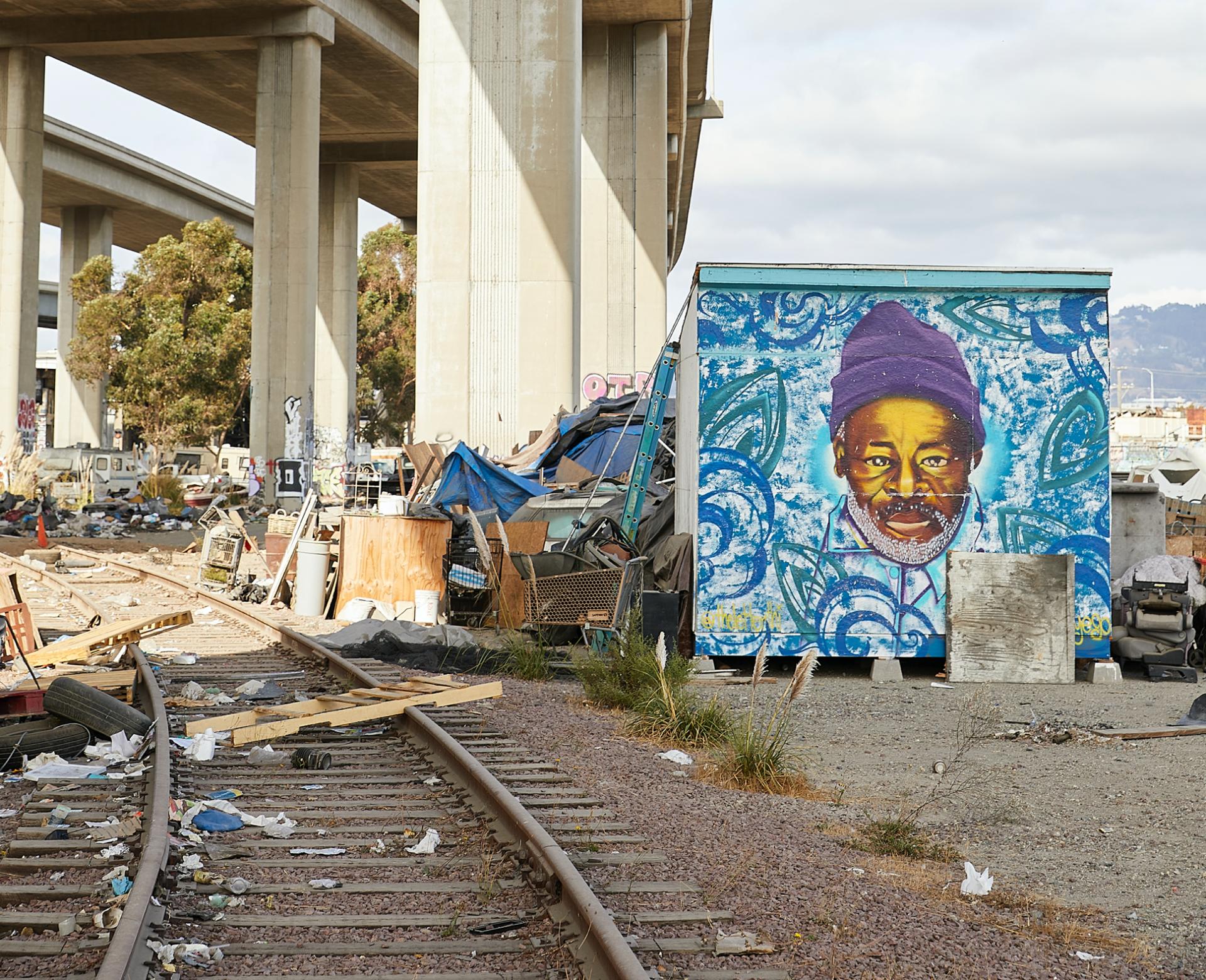
Caltrans has tried multiple times to evict the residents of Cob on Wood, suggesting that the encampment, and the frequent fires that occur within it, threaten the state agency’s critical infrastructure, such as the freeway and adjacent railroad. Harper led the charge in convincing Caltrans to allow the Cob on Wood residents to maintain their current space along Wood Street over the course of the past year. Although Caltrans has softened its eviction push for the time being, the residents and local organizers are still on guard and looking for a more permanent promise that their hard work won’t be destroyed. Recently the agency started building a fence along the railroad to try to protect its assets and reduce liability issues and has moved its equipment increasingly close to the kitchen and other community-built structures.
“There’s a constant imminent threat of losing this, and it’s hard to really know what’s going on behind the curtain,” Moreno said.
Harper said Caltrans no longer meets with the Cob on Wood residents, but “there are folks that they have to meet with that have our backs,” said Harper. In particular, District 3 councilmember Carroll Fife, along with her constituent liaison Justin Tombolesi, have been champions for the community and serve as a “bridge to connect us to different city and state agencies,” Harper said.
“The Caltrans land is much more under threat than the city-owned parcels, because it operates under its own jurisdiction on its own agency timeline,” Tombolesi said. “They don’t have to disclose to us what’s happening on their own projects.” Caltrans has previously destroyed other community projects that were constructed without the agency’s permission in the same area, including a popular skate park that was built by volunteers and demolished, despite receiving neighborhood support, due to liability issues.
Fife’s office has successfully prevented sweeps of the Wood Street Commons, which is on city property, Tombolesi added. But the residents have faced the threat of eviction there, too, as recently as this summer.
“We’ve started using art as a form of self-defense,” said Wood Street Commons resident Theo Cedar Jones. Jones, who moved to the encampment in November 2020, said the large art installments along Wood Street are an effort to transform people’s perceptions of the community. The Commons has its own showers, a “sharing patio” where donations and communal resources are available to any of its residents, and a stage for community meetings and performances.
Jones said it really became apparent that the residents of Wood Street may need to improve their image starting around March 2021. The encampments are surrounded by abandoned vehicles and other illegally dumped garbage that accumulate in the area from across Oakland. And on the city-owned parcel, there are plans to lease the land to Habitat for Humanity for the construction of a 170-unit apartment building.
“Only ten of those units are for supportive housing, eight of which are earmarked for veterans,” Tombolesi said. The affordable units—which will be priced anywhere between 20 to 120 percent of the area median income—are largely unaffordable for people living on Wood Street, he added.
Some of the residents in the encampment started organizing among themselves and with their housed neighbors to clear up the land and collect huge amounts of garbage over several weekends. Although the two West Oakland encampments have separate communal resources, communities, and governance structures, the cleanup effort united residents from Wood Street Commons and Cob on Wood.
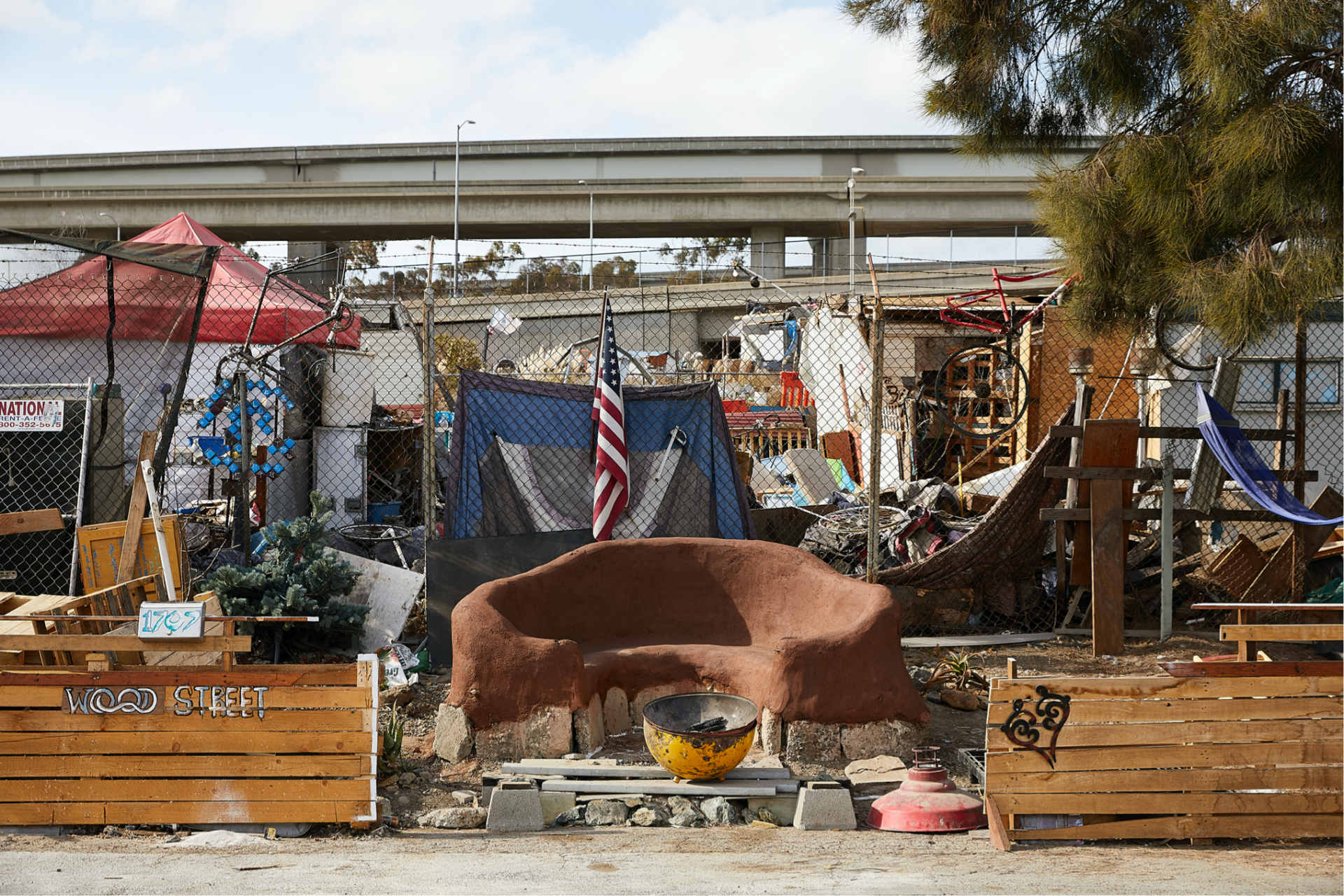
“We argued that we didn’t have to be moved. We can clean up our areas, because we know what can be thrown out,” Harper said, adding that city- or state-led sweeps often lead to the destruction of people’s property.
But the residents and volunteers received a cease-and-desist order from Caltrans anyway. Because none of the volunteers were certified to handle hazardous waste, the collection effort was shut down entirely. Jones was dismayed by the setback, because both the dumping and Caltrans’s response were distressing and threatening to the encampment as well as the natural environment.
“I don’t think ever in our history have so many housed and unhoused residents worked together for a common cause. There is an unfortunate amount of environmental damage going on,” he said.
The West Oakland communities are not seeking distinct or official city services; instead, they work to support each other and welcome donations and volunteers. The residents along Wood Street would like the opportunity to build their own form of community on public land that they see as being otherwise underutilized.
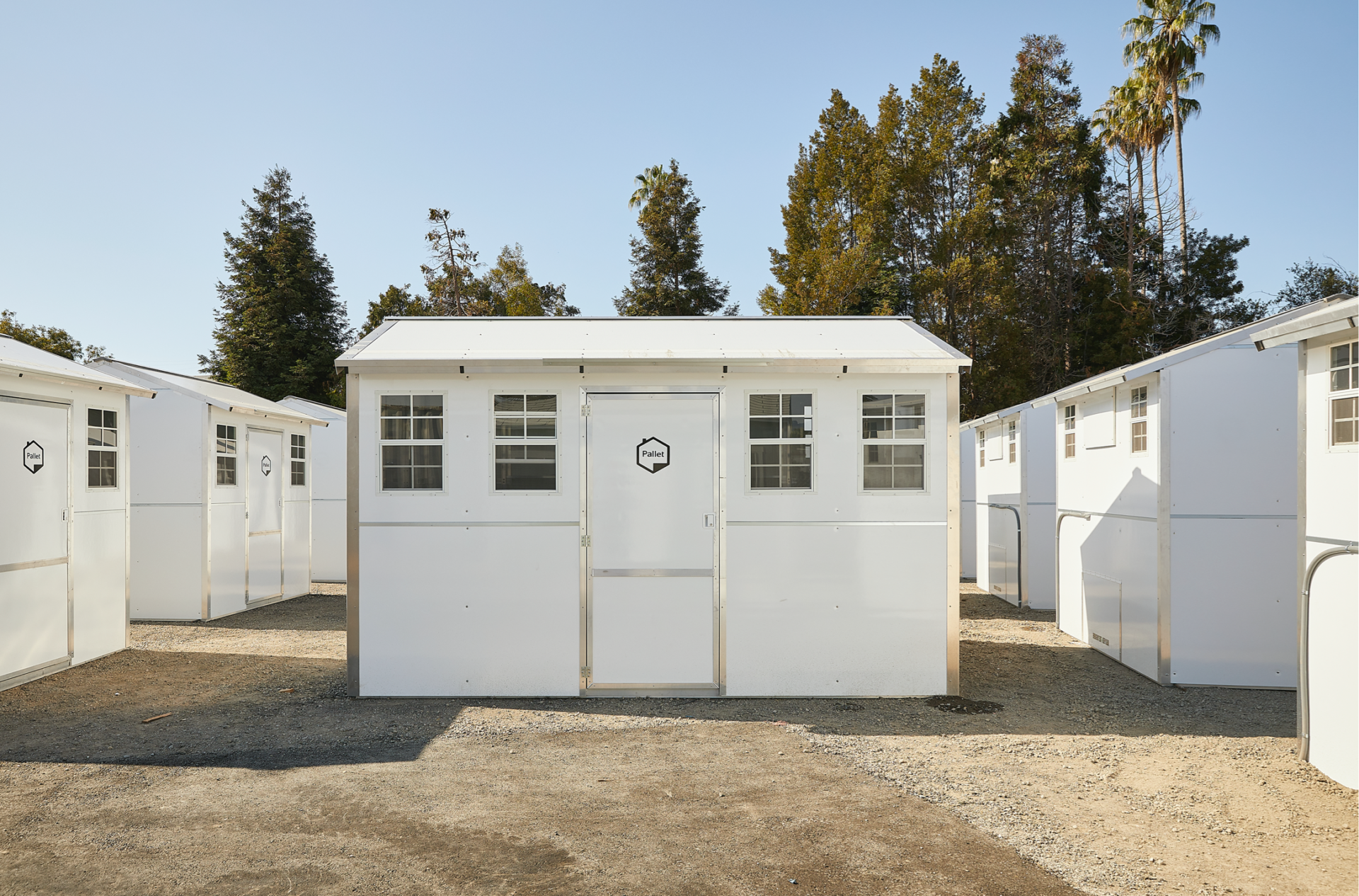
Co-Governance Pilot for a Displaced Community
A small group of tiny metal homes erected in a parcel of land near the intersection of East 12th Street and 2nd Avenue are set to house a group of people displaced in March 2021 from a large long-lived encampment at Union Point Park. In a pilot effort new to Oakland, this small Lake Merritt–adjacent community will be co-governed by residents and city officials.
Co-governed encampments have been tested in Eugene, Oregon, as well as Portland, Seattle, and other West Coast cities. In August 2020, the University of California, Berkeley, issued a report sponsored in part by the City of Oakland to study prior efforts, evaluate the pros and cons of the co-governance model, and assess the potential of a pilot in Oakland. Among other conclusions, the report’s evaluation of existing co-governed sites found the model provides “a useful framework for service provision and community engagement, and can grant agency and autonomy to unhoused individuals.”
There were about twenty residents displaced from Union Point Park, a waterfront park in southwest Oakland where some had lived for ten or more years, according to resident Lucy Brum. She and many of the residents were relocated to a shelter-in-place hotel, the Travel Inn on West MacArthur Boulevard, after organizing with the city to stay together as a group. About sixteen of the residents will move into the group of tiny homes erected by the city.
The encampment at the park was dismantled—despite city COVID protocols to leave encampments untouched—because Oakland was facing fines of up to $6,000 per day from the Bay Area Conservation and Development Commission, a state agency that oversees the protection of San Francisco Bay and the lands surrounding it.
The displaced residents wanted to remain a community and to each have their own tiny-home space, said Adam Garrett-Clark. He is an Oakland local and the tiny-home liaison for Tiny Logic, the organization contracted by the city to lead the planning and development of the co-governance procedures and the design of this tiny-home community. With this pilot, Garrett-Clark said, the residents will have the opportunity to stay together, although they were not involved in choosing the new site’s location. The first site that was proposed for relocation of the encampment was fairly close to the park, but the project was opposed by the district’s councilmember, he said.
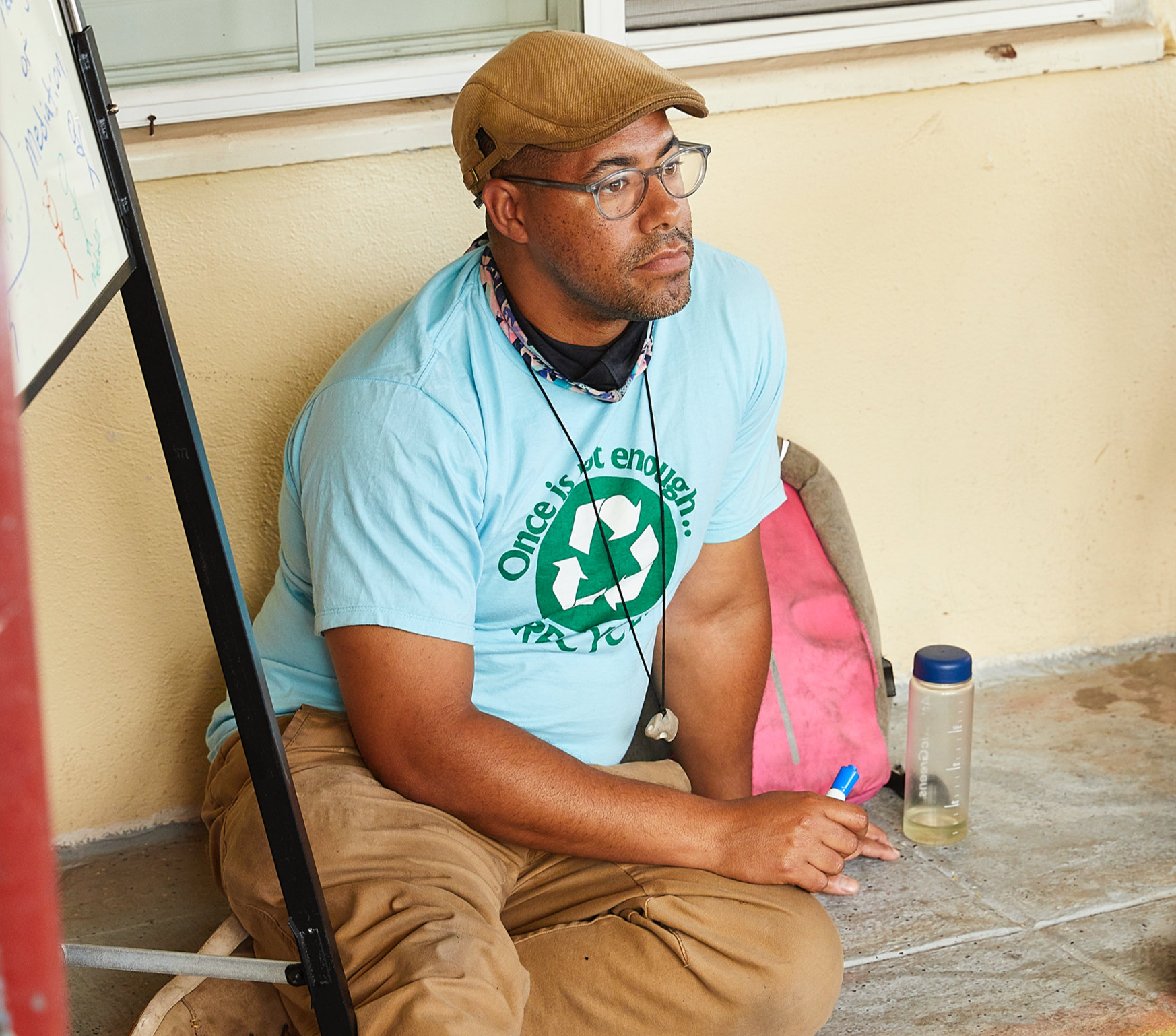
The new Lake Merritt location at East 12th Street and 2nd Avenue, secured by Oakland City Council president Nikki Fortunato Bas and her District 2 staff, was originally expected to host a large multi-use market-rate development, before the contractor’s financing fell through. So that’s where the self-governed residents will be, once electricity and other utilities have been fully activated, Garrett-Clark said. He has a contract with Oakland to provide guidance and support to the residents as they develop their co-governance structure and make final decisions on the site’s shared facilities.
Garrett-Clark has founded and provided operational support for two other tiny-home communities in Oakland. Beyond his work at Tiny Logic, he is also the executive director of Neighborship, a nonprofit aimed at providing administrative support and collaborative guidance to urban ecovillages that provide affordable housing options with shared permanent community structures. He acts as a liaison between the residents and the city, and meets with the residents weekly either at the Travel Inn or the site of their future co-governed tiny-home community.
Before they were displaced from Union Point Park, the residents had shared rules and a sense of ownership for their community, resident Deanna, or “Momma D,” said. “We’ve asked people to leave. We can’t make them leave, but if we find out they’re stealing or damaging people’s property, we tell them to stop or leave.”
The residents will collectively come up with policies to self-govern using a template that has guided similar efforts in Seattle for more than twenty years.
In addition to already-constructed tiny homes, Garrett-Clark hopes to bring volunteers in to provide art, build vegetable gardens, and construct other items for the shared spaces. There are several households with dogs that don’t always get along, so additional fencing will be necessary. Garrett-Clark and the residents are also searching for a storage solution for personal belongings that don’t fit into the eight-by-eight structures.
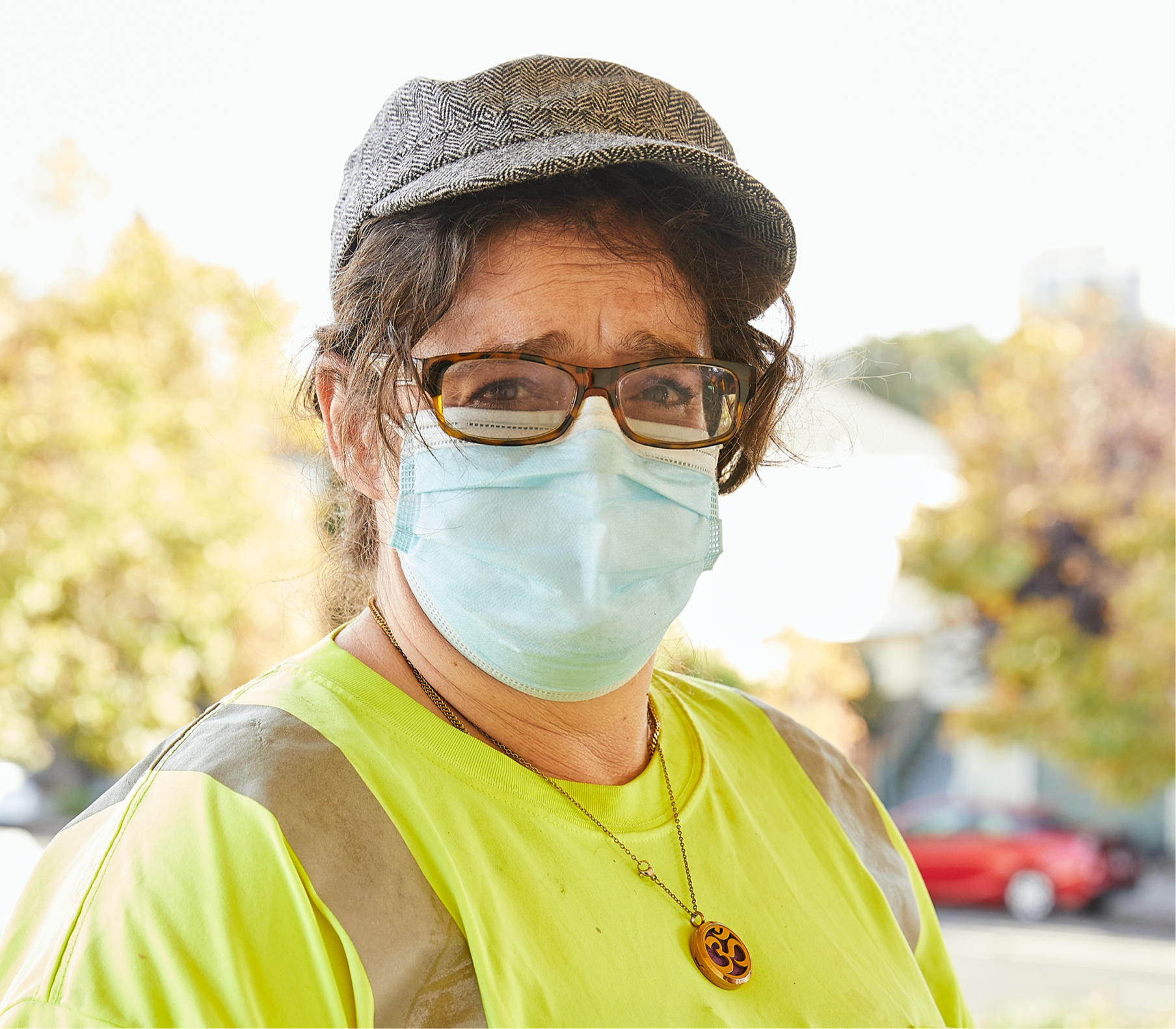
“I’m anxious because the houses are so small. They’re too small,” Brum said. She said although the residents have the option to co-govern, most of the decisions about the space—such as the size of the houses and the location of the bathrooms—have been made by the city without their input.
“I feel like we’ll be in a zoo, with people walking by, staring, and thinking ‘Oh, look how nice, you get to live here,’” Brum said. “And I’ll just be trying to decently leave the bathroom.” She suggested that some of the residents might decide to alter the houses once they move in, to expand their spaces and erect better fences for dogs and privacy. She is frustrated that the residents were left out of the decisions about how the funding allocated for the pilot was used.
“We’re homeless, we’re not stupid,” Brum said. “We have a better idea of what we need to survive than they do.”
The group has had many conversations about how to build a culture of trust to aid in shared decision-making. “There is no city involvement in the recent discussions because of the overwhelming distrust and conspiracy theories,” Garrett-Clark said. “But that’s also why this approach may be more effective, ultimately—because it involves gaining trust and helping people stabilize in a community.”
“Adam has been great in supporting us,” Brum said.
The tiny homes are from a Seattle-based company, Pallet Shelter, that ships kits that can be quickly erected and can last up to ten years after they’re constructed, according to Bas’s policy analyst and community liaison, Lia Azul Salaverry. The shelters were selected not only because they’re sturdy and fast to put up but because they provide residents the option to live alone. Many of Oakland’s prior tiny-home facilities had larger residences but were double-occupancy.
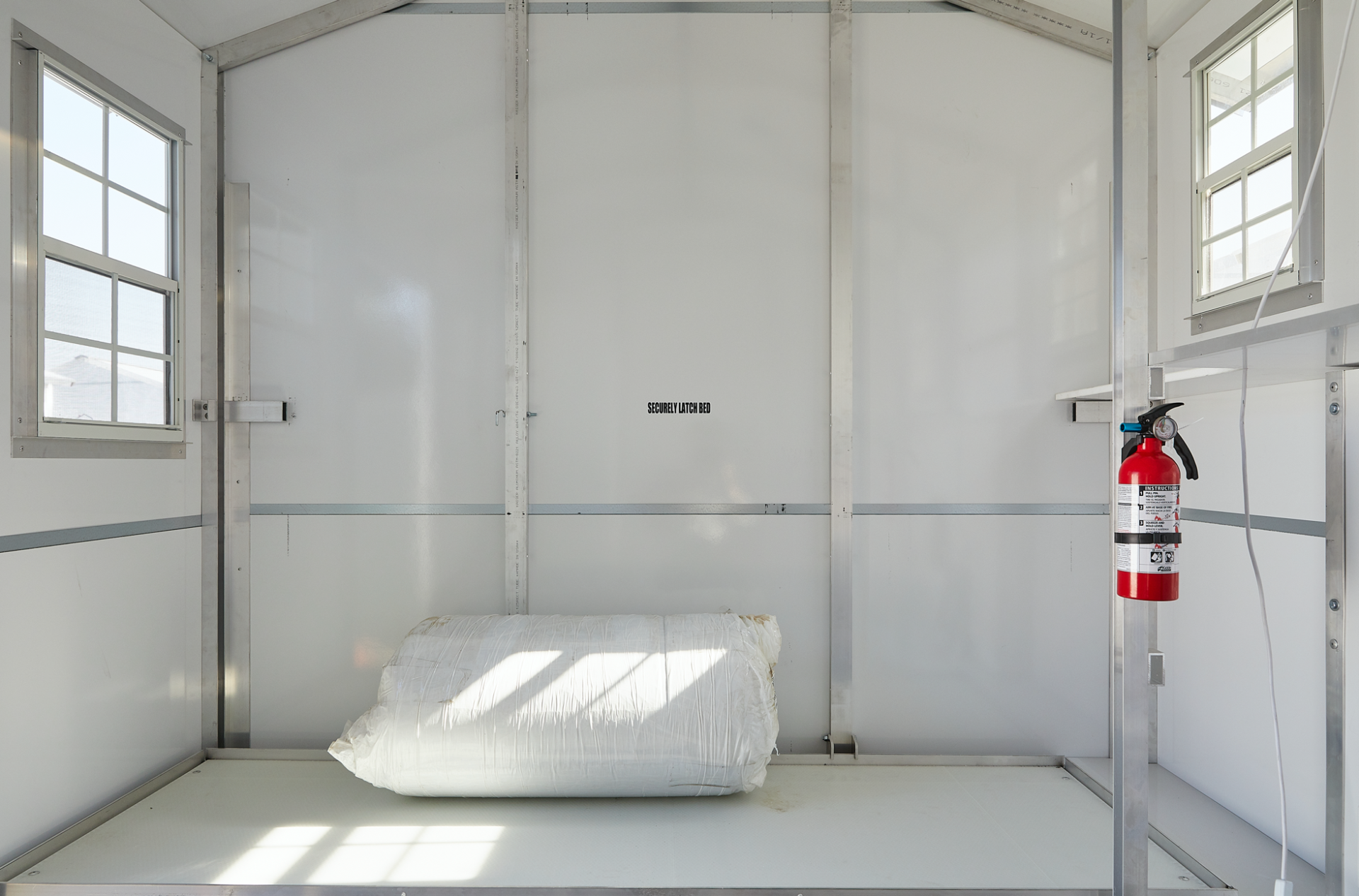
“It requires people to move in with a total stranger when they already often have a lot of suspicion and concern about property and safety,” Salaverry said. The city-run community cabins also typically have a six-month turnover rate: residents are given a short stay but are then moved along to make room for someone else. “That is far from ideal,” Salaverry said.
The residents from Union Point Park have been told they can stay at the East 12th parcel for up to three years. But that could depend on when or even whether the development’s financing comes through.
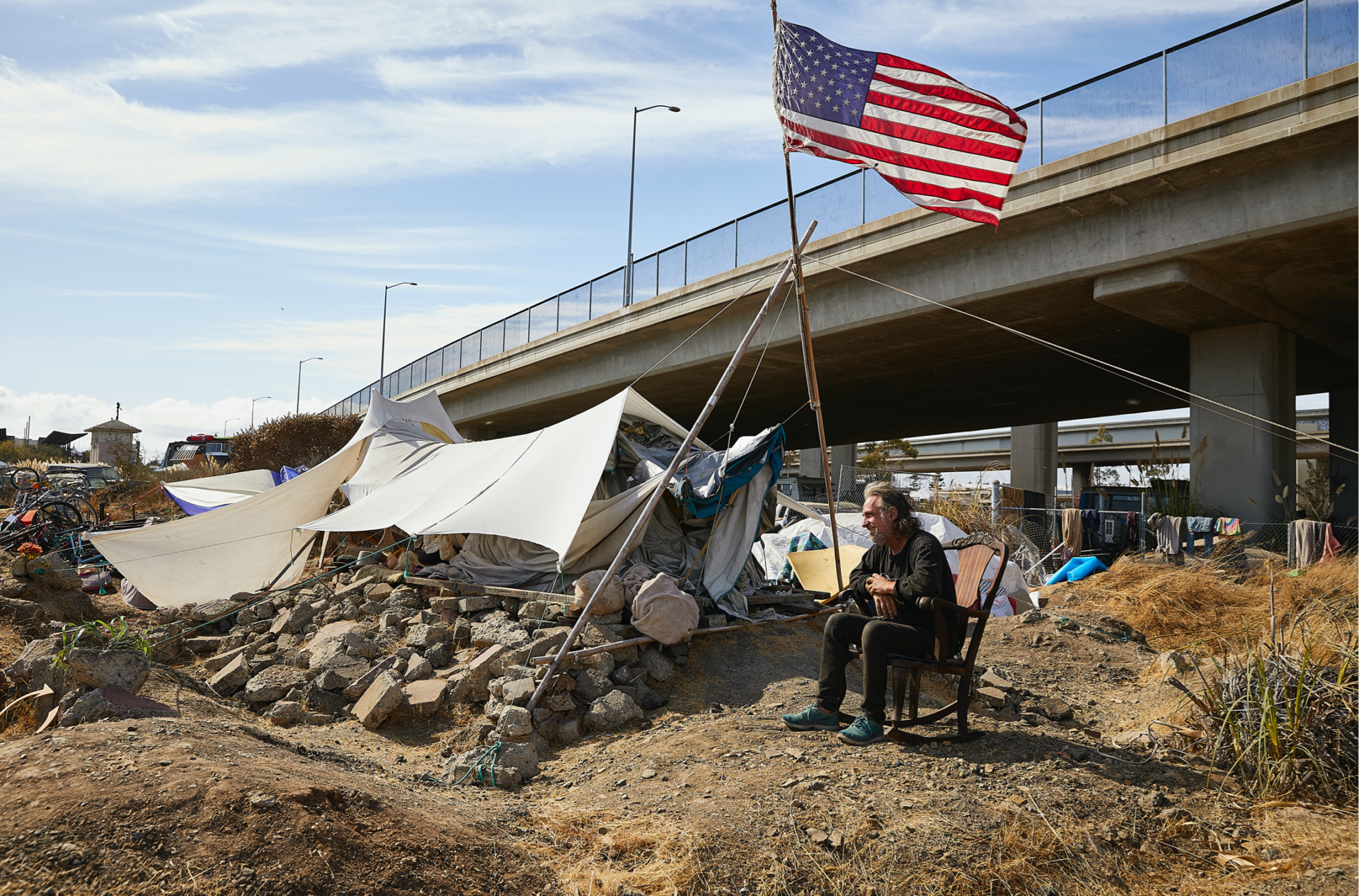
In Pursuit of Self-Agency and Safety
Although Cob on Wood and Wood Street Commons do not have a structured self-governance plan like that being developed for the Lake Merritt tiny-home community, they are each informally a co-governed site, Tombolesi said.
“We are a unique encampment in our degree of self-organization,” Jones said. This self-organization has convinced city officials to meet regularly with the residents, sometimes on-site at their self-built meeting area, and has led to concessions from the city such as a regularly scheduled waste pickup for residents.
“It’s kind of unprecedented to have city officials come to our place and see all of the work we did to clean up our encampment and create art,” Jones said. The Wood Street residents work together to try to vet those who are newly arriving to maintain the safety of everyone, he added.
Tombolesi agreed that the Wood Street residents have unique organizational skills, and said Fife’s office has been a conduit for providing Wood Street residents access to city and state agency representatives.
“[Homelessness] is the biggest crisis of our time, with roots in racialized capitalism,” Tombolesi said. “The least we can do is help people organize to improve their own condition.”
Wood Street Commons aims to keep its current location and has asked the City of Oakland for two years to pilot a tiny-home ecovillage on the site and to purchase or lease the land through its recently developed Oakland Commons land trust. The Wood Street residents’ main ask is to be engaged in various agencies’ decisions about the land they call home. They are coordinating with a statewide network of encampments, called the Solidarity Coalition, that is bargaining with Caltrans to have at least two seats on its equity committee reserved for unhoused residents.
“The solutions don’t address the issues houseless people have to face,” another resident, Lydia, told me. Lydia moved into the area over three years ago after being swept from an RV community nearby. “We’re considered service-resistant when we don’t like their solutions,” she said.
“It’s a tireless, desperate effort to keep people informed,” Commons resident Moose said. He has worked with Jones and another community leader, Lamonte, to host weekly meetings for the residents to keep everyone engaged and involved in decisions that affect the full community.
“It’s the communication that has really brought us together,” Lamonte said. “We get a sense of each other’s health—mentally and physically.”
“The Wood Street folks are outside of the system, as most homeless are,” Tombolesi said. “The problem with city-organized solutions is they are temporary. There is all this short-term hassle and constantly being moved along, so many people choose to opt out of it.”
The co-governed tiny-home village on East 12th has institutional city-supported roots, which makes it more directed and formally coordinated than the organic community development that has occurred along Wood Street. Further, the Union Point Park residents’ displacement and relocation into shelter-in-place hotels is not a typical method of clearing an encampment, so the whole evolution of the pilot has been coordinated with the city to address the specific community’s need.
But the resident-governed model being piloted there still aims to reverse the traditional top-down approach, Garrett-Clark said.
“Many people decide not to be a part of those city-supported programs because they feel disempowered and restricted. This [co-governed] model provides more empowerment,” he said.
While the co-governance pilot provides some additional self-agency, the reservations expressed by Brum, Momma D, and other residents suggest the constructed environment could impact the success of their community.
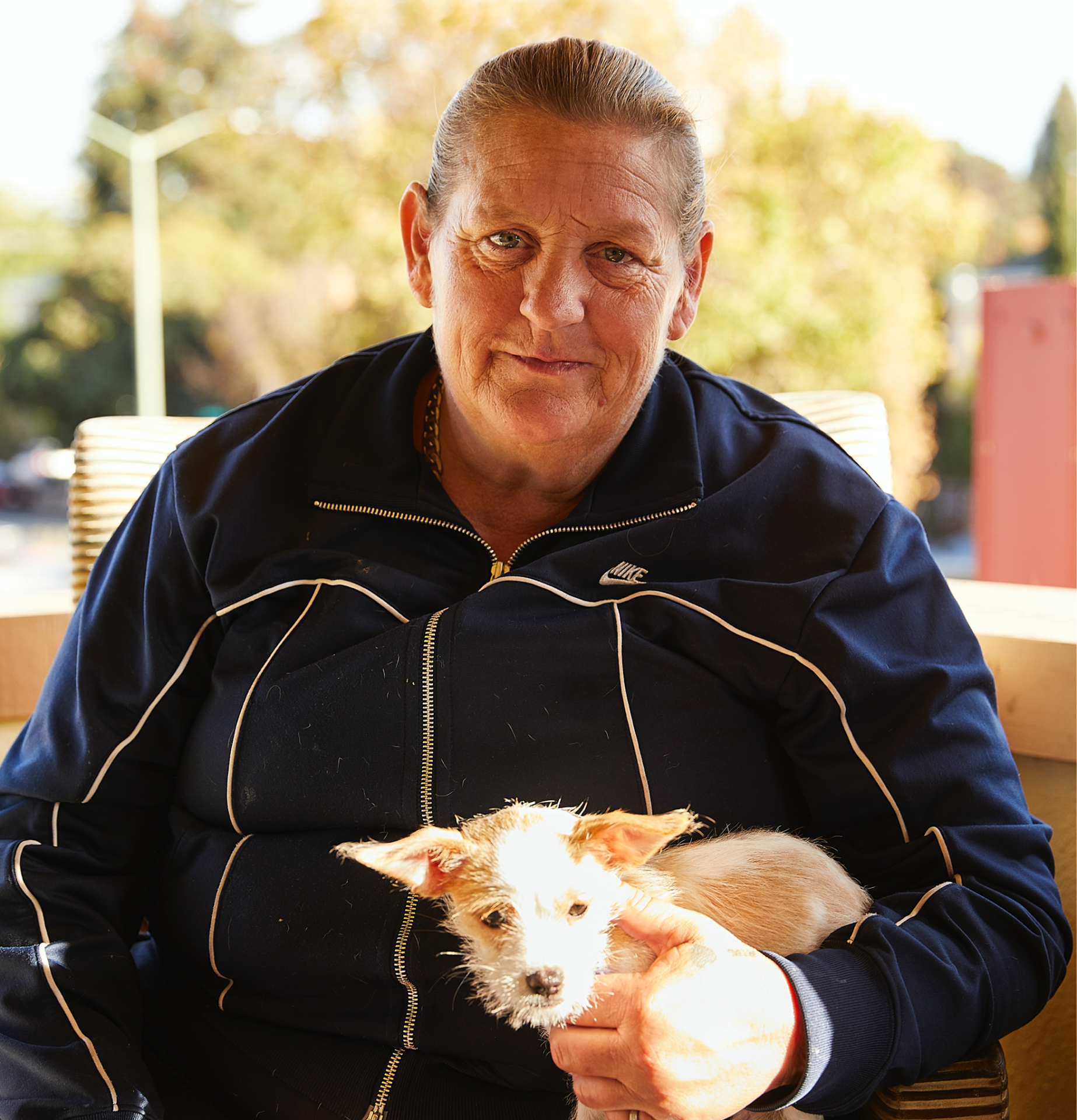
“I always have my stuff organized so I’m ready to go on short notice,” Brum said. She has several saws on hand and friends with construction skills who will be on call to help modify her tiny home.
“I know I’ll wind up having to cut a hole in the wall . . . it will be too claustrophobic,” she said.
“Even the couples are choosing to have two separate units, because they are so small,” Momma D added. During their weekly meetings, the residents are collaborating not only to finalize their governance strategy but also to agree on a design for the communal kitchen and an altar and meditation space to remember the community members that have been lost in recent years. Garrett-Clark will take their feedback to the city to help finalize the community’s design. The co-governed tiny-home village will also have twenty-four-hour security and access to city health services.
The Wood Street residents have more space but lack official resources and have less security. They only recently received several large rolling trash cans and garbage service. Arsonists have been setting fires to vehicles and other structures, which Jones views as an effort to clear out the people living there. Still, their collaboration makes their community strong and resilient.
“We are installing a putting green,” Lamonte said. Moose has plans to open a small breakfast café and bike shop in his section of the Commons. The residents enjoy hosting parties as a way to welcome neighbors to their space and share the music, art, and community they have built.
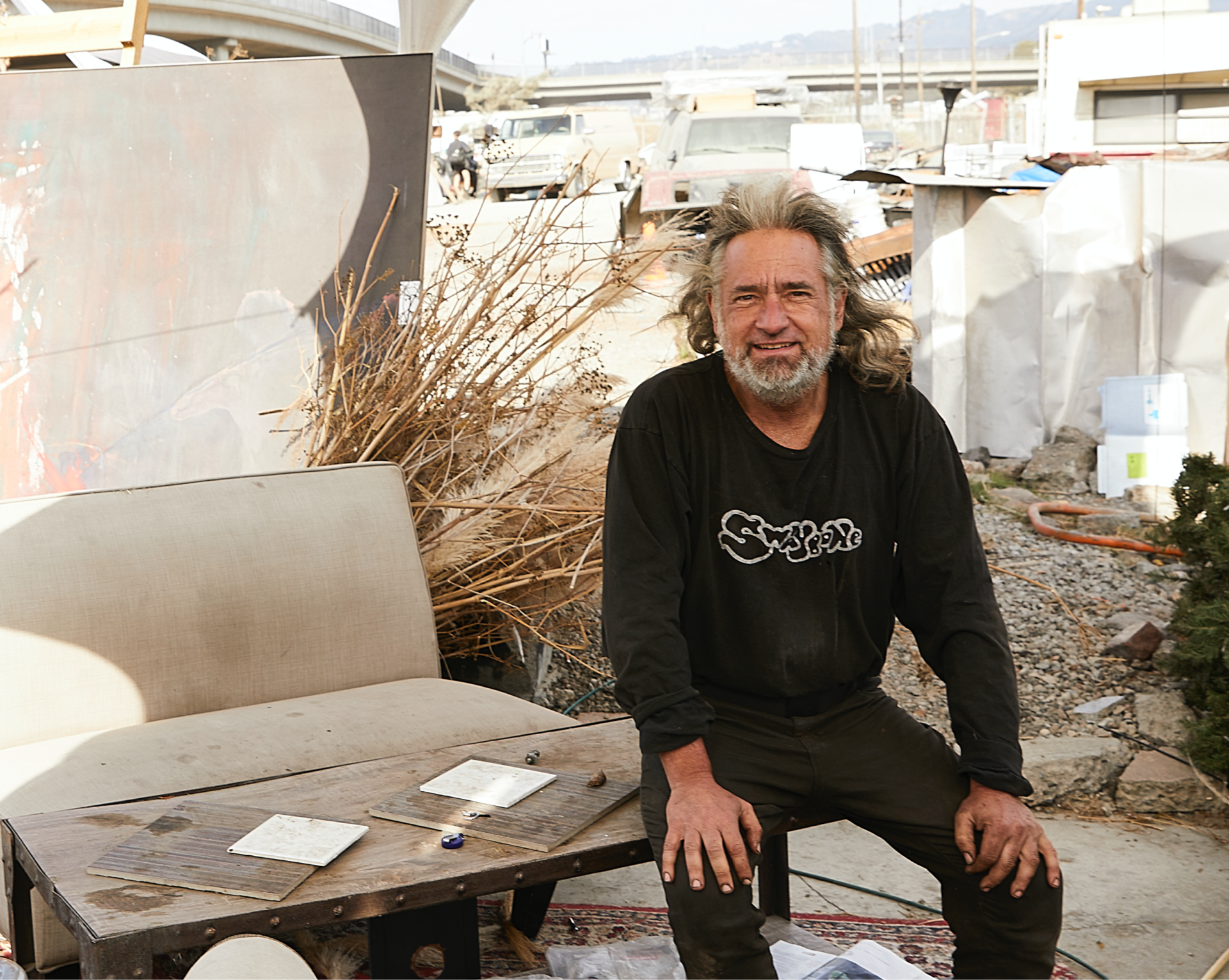
“We want to live outside, build our own shelters and lives, and stay engaged with and on the earth,” Jones said. “Now that I’ve lived this way, I don’t want to go back to standard housing. I want to live in communal encampments and support others and create solidarity.”
“We are the new face of homelessness,” Harper said. “We’re not just on the street asking for change anymore. We are trying to address the stigma by creating art and community.” ♦
. . .
Postscript: In late December of 2021, the City of Oakland ended its contract with Tiny Logic and transferred management of the co-governed transitional housing community (now known as Union Point on the Rise) to the Housing Consortium of the East Bay. Residents were able to move into the tiny homes in mid-January of 2022, but construction was not completed, and the future of these facilities remains uncertain. Adam Garrett-Clark, housing liaison for Tiny Logic, has chronicled his perspective on the efforts and challenges in his blog post, The Rise and Fall of Oakland’s First Co-Governed Tiny House Community.
More information and updates on Wood Street Commons, including a video discussion with some of the residents, are available at https://www.woodstreetcommons.
. . .
Carrie Sisto is a freelance reporter based in Oakland. She has been covering Bay Area news and events since 2016 for Hoodline, The San Francisco Examiner, and Here/Say Media, and works at the California Public Utilities Commission.
Nico Oved is an Oakland–based Canadian photographer specializing in portraiture and food. On weekends, you’ll find him baking sourdough bread and irrationally supporting his unremarkable hometown soccer team, Toronto FC.


